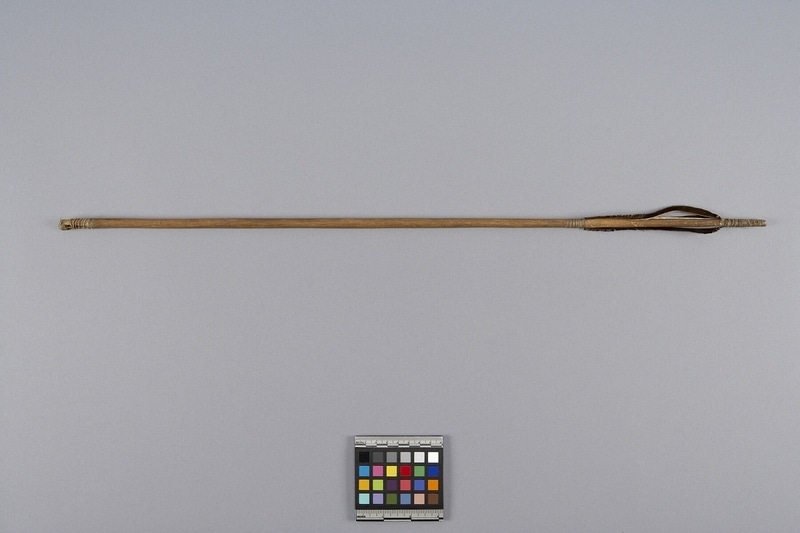Arrow Item Number: A9260 from the MOA: University of British Columbia

Description
Arrow consisting of long cylindrical wooden shaft with notches and wrapped sinew at each end. At the base end of the shaft are three strips of dark grey feather, each approximately 13.5 cm long, secured to the shaft with sinew. The sinew at one end is coming unraveled due to the lack of metal point.
History Of Use
The bow was used as the primary weapon for hunting land animals. Arrows were specialized for hunting animals or birds. Arrows used for bird hunting had "a hardwood knob or a fiber wrapping at the end of the shaft (Barnett 1955:102)." While a very common shape for other types of arrows was a " point [that] was five or six inches long. Both for hunting and warfare, it was set into a slot in the blunt, untapered end of the shaft in such a way that, when the victim was pierced, the shaft dropped off and the point remained in the wound (1955:102)." Wilson Duff reports that arrows of bone and ground stone were used by the Sto:lo for hunting, while those of chipped stone were used for war. He adds that the war point were sometimes poisoned by dipping them in the human brain (see 1952:59).
Cultural Context
hunting; warfare
Narrative
This arrow was found in a shell heap near New Westminster, with four others, probably between 1920-1927.
Specific Techniques
Wilson Duff reported that the Sto:lo made arrows from serviceberry wood, and that "some persons used small round sprouts, but deer hunters used larger and tougher stems split into four and rounded. The point of the arrow was charred and sharpened, and this sufficed for a point in most cases. Sometimes, however, points were made of ground slate...[also] of bone, ground stone, and chipped stone... Arrows were feathered with the whole tail feathers of mallard ducks or woodpeckers. Two feathers were used, laid on tangentially opposite each other. The feather was laid on the arrow, quill-end toward the butt, and the end of the vane was tied to the arrow with deer sinew. The quill-end was brought forward and tied down forward of the previous lashing. Sometimes it was given a half-twist to impart a rotary motion to the arrow in flight" (from The Upper Stalo Indians. 1952:59).
Item History
- Made in British Columbia, Canada before 1927
- Collected in New Westminster, British Columbia, Canada between 1920 and 1927
- Owned by Frank Burnett before 1927
- Received from Frank Burnett (Donor) on July 25, 1927
What
Who
- Culture
- Coast Salish: Sto:lo: Kwantlen
- Previous Owner
- Frank Burnett
- Received from
- Frank Burnett (Donor)
Where
- Holding Institution
- MOA: University of British Columbia
- Made in
- British Columbia, Canada
- Collected in
- New Westminster, British Columbia, Canada
When
- Creation Date
- before 1927
- Collection Date
- between 1920 and 1927
- Ownership Date
- before 1927
- Acquisition Date
- on July 25, 1927
Other
- Condition
- good
- Current Location
- Case 7
- Accession Number
- 2191/0218